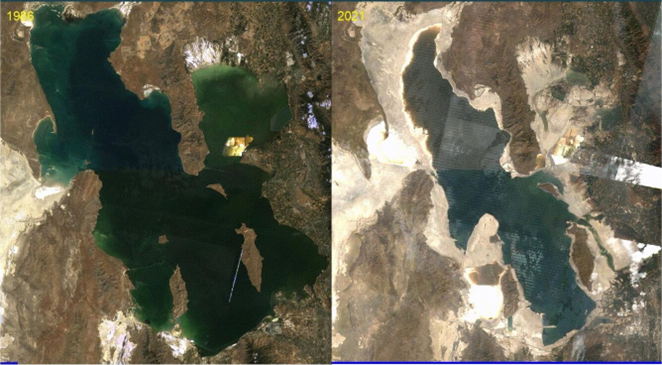Saving the Great Salt Lake
Utah’s Great Salt Lake is the largest wetland ecosystem in the U.S. West, as well as the largest salt lake in the whole Western Hemisphere and the eighth largest in the world. Best known for its phenomenal bird populations, the lake and its associated wetlands and uplands provide habitat for as many as 12 million birds from 338 species. The area around the lake is also home to many species of reptiles and amphibians and 64 species or subspecies of mammals. Through a process known as the lake effect, the Great Salt Lake contributes up to 10% of Utah’s snowpack.
Natural History
The Great Salt Lake is the remnant of Lake Bonneville, a vast freshwater lake that existed during the last Ice Age, covering most of western Utah and small portions of eastern Nevada and southern Idaho. Around 18,000 years ago, the lake began to shrink due to a colossal flood discharging its waters, followed by drying and warming, giving rise to today’s Great Salt Lake.
The lake became salty because it has no outlets — no rivers or streams carrying water away from it — but it does have inputs: rivers carrying in water and dissolved salts. As water evaporates from the surface of the Great Salt Lake, the salts are left behind, gradually building up over time.
Because the Great Salt Lake’s waters are salty, they’re perfect habitat for brine flies and brine shrimp — a tasty treat for many birds, including Wilson’s phalaropes and eared grebes, who stop at the lake during their migrations and gobble enough briny prey to double their weight, fueling long migrations to their wintering grounds. The lake’s surrounding wetlands also provide high-quality habitat for both migrating and nesting birds.
Threats
The biggest threat to the Great Salt Lake ecosystem is decreasing water levels from the diversion of freshwater inputs for agriculture and other human uses. Those water levels are even lower because climate change is causing less water to flow into the lake and more of its water to evaporate due to hotter temperatures. The lake has already lost 60% of its surface area, and in 2022 it dropped to its lowest level in recorded history.
As the water level drops, so does the amount of lake and wetland habitat available to birds, and of course, the salinity level increases — much faster and more dramatically than it naturally would. In 2022 the lake’s salinity reached levels known to impair the survival of brine flies and brine shrimp, and its loss of water dried up a huge proportion of the lake’s submerged microbialite rocks, which brine flies need for reproduction.
So the drying of the Great Salt Lake ecosystem and its increasingly salty waters now threaten the health and survival of hundreds of bird species — particularly species like Wilson’s phalaropes and eared grebes, who congregate on the lake by the hundreds of thousands.
Meanwhile lower lake levels are also exposing toxic dust from the lakebed, threatening the health of wildlife and human populations around it. Other threats to the ecosystem include pollution, the spread of invasive plants called phragmites, and nearby development of inland ports — industrial distribution centers that connect different modes of transportation (like trucks and waterways) to move goods. These ports jeopardize thousands of acres of wetlands that are part of the Great Salt Lake ecosystem.

The Great Salt Lake in 1986 and 2021 (courtesy USGS).
Our Campaign
The Center’s Great Basin program has sued the state of Utah for its failure to ensure that enough water reaches the Great Salt Lake to prevent ecological collapse. We’ve also petitioned the U.S. Fish and Wildlife Service to protect Wilson’s phalaropes under the Endangered Species Act, and we’re working with the Stop the Polluting Port Community Coalition to protect the environment around the lake from Utah inland port development.
Check out our press releases to learn more about the Center's actions to save the Great Salt Lake.







